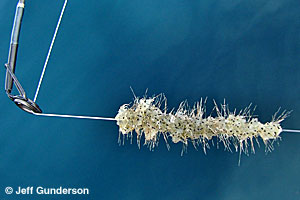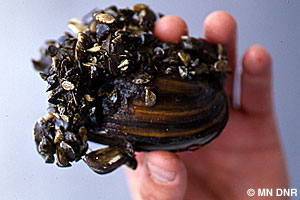
Alien invaders, part 2
Aliens are invading our lakes, the sequel! A while ago, I wrote about aquatic invasive plants (7/15/07 Detroit Lakes Tribune). Today, I will cover some common aquatic invasive animals, why they are harmful to our lakes, what the status is in this area and what you can do to protect our lakes.
I'll start out again by defining some commonly used terms. The terms "exotic", "alien", and "nonnative" can all be used to describe a species that does not naturally occur here, and has been brought here either accidentally or intentionally. In contrast, "native" animals occur naturally and are fully integrated into the ecosystem.
When an animal is introduced to a new area and out-competes native species, it is considered "invasive" and "nuisance" species. Invasive aquatic animals can get out of control because there is nothing in the ecosystem naturally to keep the population in check, they can also displace native beneficial species.
The animals I'll talk about today are Rusty crayfish, Spiny water flea, and Zebra mussels. For pictures and more information, you can visit: http://www.dnr.state.mn.us/invasives/aquaticanimals/index.html.
Rusty crayfish are native to the Ohio River valley, and were probably brought to Minnesota by non-resident fishermen for bait. Invading rusty crayfish can displace native crayfish, reduce the amount and kinds of aquatic plants and invertebrates, and reduce some fish populations. In Minnesota, it is now illegal to sell live crayfish as bait and a DNR permit is required to commercially harvest or culture crayfish. Rusty crayfish can be identified by looking for a red dot on each side of its mid-section. Also, its claws have black tips. The Rusty crayfish is difficult to control once it's introduced, so the best way to control it is to prevent its spread.

The Spiny water flea is native to Eurasia, but has spread to the Great Lakes through ship ballast water. These tiny crustaceans have now spread to inland lakes in northeast Minnesota. They compete with native fish for food and they also cling onto your fishing line in masses and clog the first eyelet of rods, damage a reel’s drag system, and prevent fish from being landed. They are difficult to see as individuals because they are only 1/4-5/8 inches (5-15 mm) in length and have clear bodies. You can however see them in clumps on your fishing line. They look like a gelatinous ball with black dots (their eyespots). It is impossible to control the spiny waterflea, so the best way to control it is to prevent its spread.

Zebra mussels are posed to become a multibillion-dollar threat to North America’s industrial, agricultural and municipal water supplies, and could become a costly nuisance for freshwater shipping, boating, fishing, and claming as well. Zebra mussels have now spread from the Great Lakes into some lakes in Minnesota, to see a list visit http://files.dnr.state.mn.us/eco/invasives/infestedwaters.pdf. They are currently not found in any Becker or Ottertail county lakes, but they are nearby in Crow Wing and Mille Lacs counties. Zebra mussels filter a quart of water each day, but they don't consume everything they take in. What they don't eat is combined with mucus as "pseudofeces" and discharged onto the lake bottom where it accumulates. This substance is what clogs intakes and allows zebra mussels to attach themselves to nearly any surface, including live native mussels. Zebra mussels are ¼ to 1 ½ inches long and are D-shaped with alternating black and brown stripes. Again, they are difficult to control, so we need to be careful and limit their spread.

We are lucky in Becker and Ottertail counties, because so far these invasive species have not been found here. However, these invasive species are in neighboring counties, and with all the tourism in our area lakes, there is always a chance these species could establish here.
To limit the spread of these invasive animals, there are some precautions you can take. Inspect and remove all aquatic plants and animals from your boat, motor, and trailer each time you enter and leave a lake. Examine boat hulls, swimming platforms, docks, aquatic plants and other objects along shorelines of lakes, rivers, and streams for zebra mussels. Drain lake or river water from your livewell and bilge before leaving boat accesses. Dispose of unwanted live bait in the trash – not the lake. Never dump live fish or other animals from one body of water into another. At boat landings, there are usually DNR signs telling which invasive species are present in the waterbody and how to prevent their spread.
You can also report new sightings if you think you have found one of these animals. Record the exact location and store specimens in rubbing alcohol; if in Minnesota call the MN DNR Invasive Species Program in St. Paul, 1-888-MINNDNR.
Please be vigilant in the spread of aquatic invasive species. Keep recreation on our lakes enjoyable and the lake ecosystem healthy. For more information and pictures of these animals, visit: http://www.dnr.state.mn.us/invasives/aquaticanimals/index.html.
Until next week, enjoy the lakes!
Moriya Rufer is the Lakes Monitoring Program Coordinator for RMB Environmental Laboratories in Detroit Lakes, 218-846-1465, lakes.rmbel@eot.com.